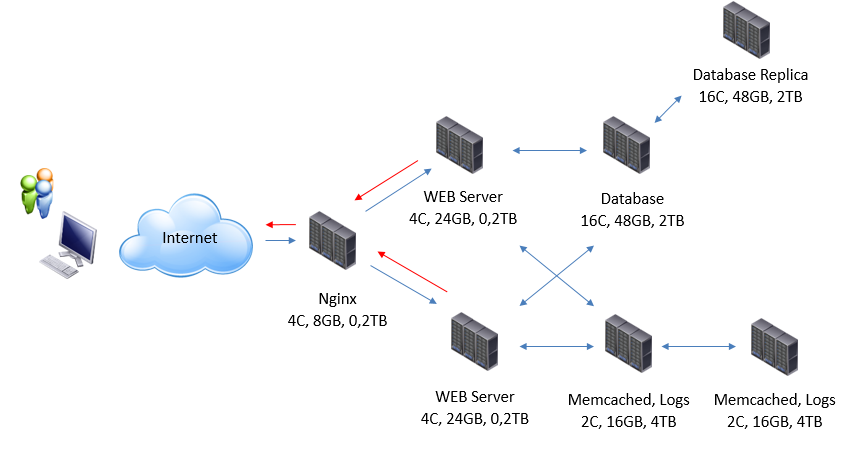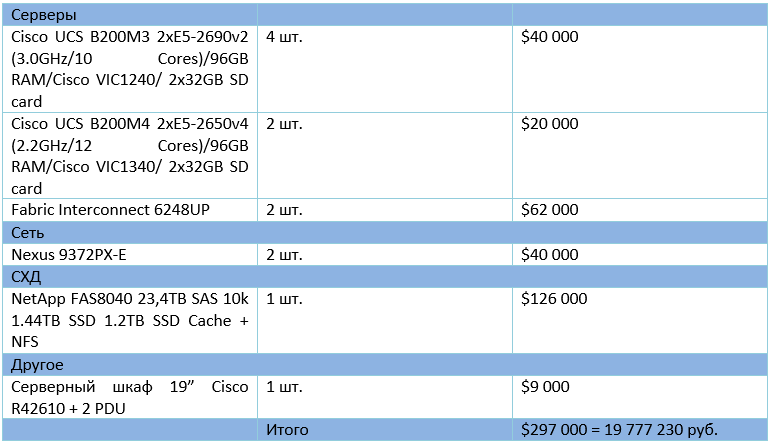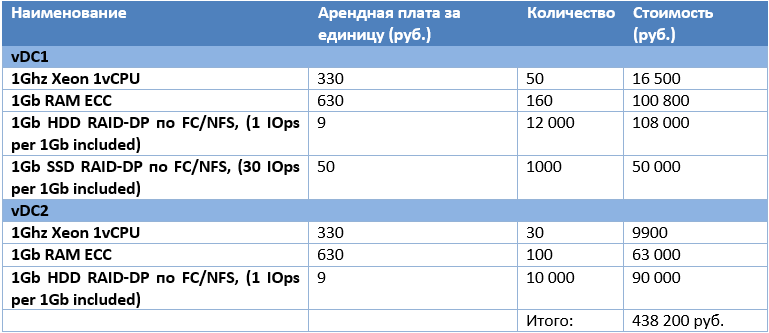What are the Benefits: Feasibility Study for Using IaaS
The need for a feasibility study of the transition to the cloud usually occurs in two cases:
Consider the second option and take the situation when you need to launch a relatively large online store as a reference point. / photo Serge Kij CC Before proceeding to costing, you should determine for yourself the general scheme of the project and the technical component. Suppose that in our case the hardware will include a Nginx server (Intel Xeon 2.6 GHz, 4C, RAM 8 GB, HDD 2 TB SAS) and two web servers (Intel Xeon 2.6 GHz, 4C, RAM 24 GB, HDD 2TB SAS) . It will also include two database servers (Intel Xeon 2.6 GHz, 16C, RAM 48 GB, HDD 2TB SAS) and two log servers - Memcached, Logs (Intel Xeon 2.6 GHz, 2C, RAM 16 GB, HDD 4TB SAS). The general scheme of the project looks like this:


In our case, suppose that it was decided to purchase Cisco UCS blade servers with Fabric Interconnect, a Cisco Nexus switch for network connectivity, and NetApp solutions as storage (by the way, we did anboxing of the Cisco UCS solution). When deploying such an IT infrastructure, the company will face capital and operating costs.
This type of cost includes:
Thus, the formula for calculating the costs of creating a hardware platform (K) takes the following form:
Suppose that the cost of infrastructure design is 120,000 rubles (the work lasted 120 hours at a price of 1,000 rubles per hour). Installation costs are 32,000 rubles at a cost of 800 rubles per hour, and the cost of training one employee is 80,000 rubles (at 40 hours of training and 2,000 rubles per hour). Total 232,000 rubles.
Now let's calculate the costs of equipment:

As a result, we find that the costs of creating a hardware platform (K) are:
In addition to the costs of acquiring and installing hardware, it is necessary to take into account the cost of software, which consists of the costs of software licenses (K persons ), the costs of installation and configuration (K instPO ), and the costs of training specialists (K training ).
Suppose that in the case under consideration, the organization’s employees are familiar with the software provided — therefore, the training costs will be zero.
Installation and configuration of infrastructure software will be carried out by one specialist of the company, who takes 800 rubles per hour and estimated the duration of work at 40 hours. It will also purchase 12 VMware vSphere Enterprise Plus licenses for $ 2,300 each.
Thus, the total cost of infrastructure software is:
Unlike capital costs, operating costs are characterized by a repeating nature, that is, they are measured in monetary units per unit of time (rubles per year).
Operating costs include:
Thus, operating costs are calculated by the formula:
In our case, the operating costs for IT infrastructure are 7 524 444 rubles per year (a detailed analysis of operating costs with calculation formulas for each component can be found here ).
In addition, a few words should be said about hardware redundancy and increasing computing power. Hardware redundancy leads to unused capacity, which is needed only if one of the main servers fails or the company expects a certain growth in the future, therefore it buys equipment “in reserve”. It also affects the cost of servicing the hardware.
Now consider the option of acquiring a cloud service in the IaaS model, for which we express the necessary components in the CPU, RAM cores and disk space. Using a cloud service in the IaaS model, the client rents a dedicated virtual platform, thereby shifting part of the responsibility and costs to the shoulders of the hosting provider.
In the case of IaaS, there are only operational costs that are measured in monetary terms per unit of time.

Thus, the company will pay the cloud provider an amount of 5,258,400 rubles annually, which is much cheaper than building and maintaining its own IT infrastructure. Given that the company will not have to make a one-time purchase of equipment (24 million rubles) and its further maintenance, resulting in a waste of 7 million rubles per year.
Carrying out such calculations is a rather painstaking task: in order to calculate the real benefits from the implementation of a particular format of IT infrastructure, it is necessary to take into account many factors and figures that economists are used to working with.
Nevertheless, such a calculation can show companies that in most cases, the benefits of migrating to the cloud are expressed not only “in words”, but also in real numbers. For a more detailed study of the feasibility studies for the implementation of cloud technologies, you can read our book, " The Business Case for Cloud Migration for the IaaS Model ."
- It is necessary to modernize the existing infrastructure
- It is planned to create IT infrastructure from scratch
Consider the second option and take the situation when you need to launch a relatively large online store as a reference point. / photo Serge Kij CC Before proceeding to costing, you should determine for yourself the general scheme of the project and the technical component. Suppose that in our case the hardware will include a Nginx server (Intel Xeon 2.6 GHz, 4C, RAM 8 GB, HDD 2 TB SAS) and two web servers (Intel Xeon 2.6 GHz, 4C, RAM 24 GB, HDD 2TB SAS) . It will also include two database servers (Intel Xeon 2.6 GHz, 16C, RAM 48 GB, HDD 2TB SAS) and two log servers - Memcached, Logs (Intel Xeon 2.6 GHz, 2C, RAM 16 GB, HDD 4TB SAS). The general scheme of the project looks like this:


Purchasing equipment and building your own IT infrastructure
In our case, suppose that it was decided to purchase Cisco UCS blade servers with Fabric Interconnect, a Cisco Nexus switch for network connectivity, and NetApp solutions as storage (by the way, we did anboxing of the Cisco UCS solution). When deploying such an IT infrastructure, the company will face capital and operating costs.
Hardware platform purchase costs
This type of cost includes:
- The cost of designing a hardware complex (K pr app ),
- The cost of the purchase of the north (K SRV ),
- The cost of the data storage system (K SCD ),
- Costs of network equipment and cables (K set ),
- The cost of training specialists (K training ),
- Installation costs (K inst app ).
Thus, the formula for calculating the costs of creating a hardware platform (K) takes the following form:
K = K pr ann + K EOT + K storage + K set + K trained + K inst ann
Suppose that the cost of infrastructure design is 120,000 rubles (the work lasted 120 hours at a price of 1,000 rubles per hour). Installation costs are 32,000 rubles at a cost of 800 rubles per hour, and the cost of training one employee is 80,000 rubles (at 40 hours of training and 2,000 rubles per hour). Total 232,000 rubles.
Now let's calculate the costs of equipment:

As a result, we find that the costs of creating a hardware platform (K) are:
K = 232,000 + 19,777,230 = 20,009,230 rubles.
Software costs
In addition to the costs of acquiring and installing hardware, it is necessary to take into account the cost of software, which consists of the costs of software licenses (K persons ), the costs of installation and configuration (K instPO ), and the costs of training specialists (K training ).
K by = K persons + K instPO + K training
Suppose that in the case under consideration, the organization’s employees are familiar with the software provided — therefore, the training costs will be zero.
Installation and configuration of infrastructure software will be carried out by one specialist of the company, who takes 800 rubles per hour and estimated the duration of work at 40 hours. It will also purchase 12 VMware vSphere Enterprise Plus licenses for $ 2,300 each.
Thus, the total cost of infrastructure software is:
To by = 1,837,884 + 32,000 = 1,869,884 rubles.
Operating costs for IT infrastructure
Unlike capital costs, operating costs are characterized by a repeating nature, that is, they are measured in monetary units per unit of time (rubles per year).
Operating costs include:
- The cost of operating your own server (C data center )
- The cost of operating the hardware (C app )
- The cost of operating the software part (C to )
- Costs of maintenance and management personnel (C pers , C unitary enterprise )
Thus, operating costs are calculated by the formula:
C = DPC + C ann + C on the + C pers + C y
In our case, the operating costs for IT infrastructure are 7 524 444 rubles per year (a detailed analysis of operating costs with calculation formulas for each component can be found here ).
In addition, a few words should be said about hardware redundancy and increasing computing power. Hardware redundancy leads to unused capacity, which is needed only if one of the main servers fails or the company expects a certain growth in the future, therefore it buys equipment “in reserve”. It also affects the cost of servicing the hardware.
Using a Cloud Service in an IaaS Model
Now consider the option of acquiring a cloud service in the IaaS model, for which we express the necessary components in the CPU, RAM cores and disk space. Using a cloud service in the IaaS model, the client rents a dedicated virtual platform, thereby shifting part of the responsibility and costs to the shoulders of the hosting provider.
In the case of IaaS, there are only operational costs that are measured in monetary terms per unit of time.

Thus, the company will pay the cloud provider an amount of 5,258,400 rubles annually, which is much cheaper than building and maintaining its own IT infrastructure. Given that the company will not have to make a one-time purchase of equipment (24 million rubles) and its further maintenance, resulting in a waste of 7 million rubles per year.
Carrying out such calculations is a rather painstaking task: in order to calculate the real benefits from the implementation of a particular format of IT infrastructure, it is necessary to take into account many factors and figures that economists are used to working with.
Nevertheless, such a calculation can show companies that in most cases, the benefits of migrating to the cloud are expressed not only “in words”, but also in real numbers. For a more detailed study of the feasibility studies for the implementation of cloud technologies, you can read our book, " The Business Case for Cloud Migration for the IaaS Model ."
